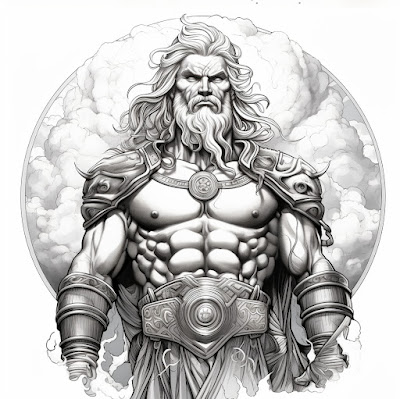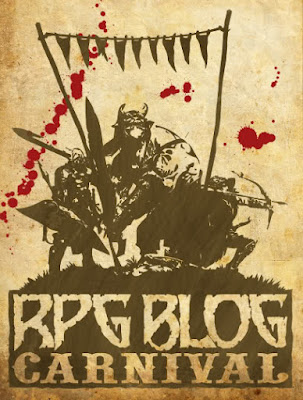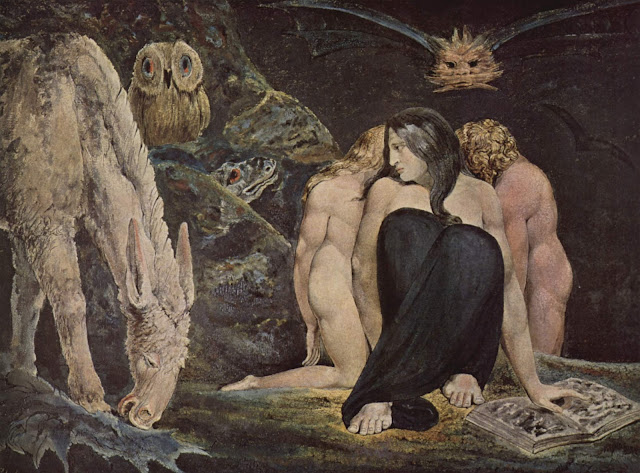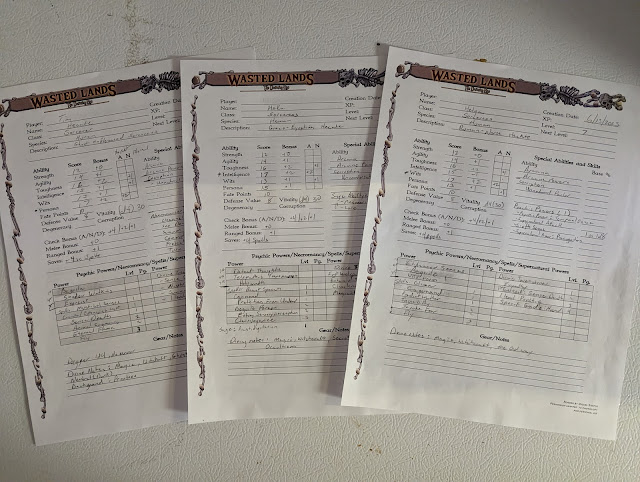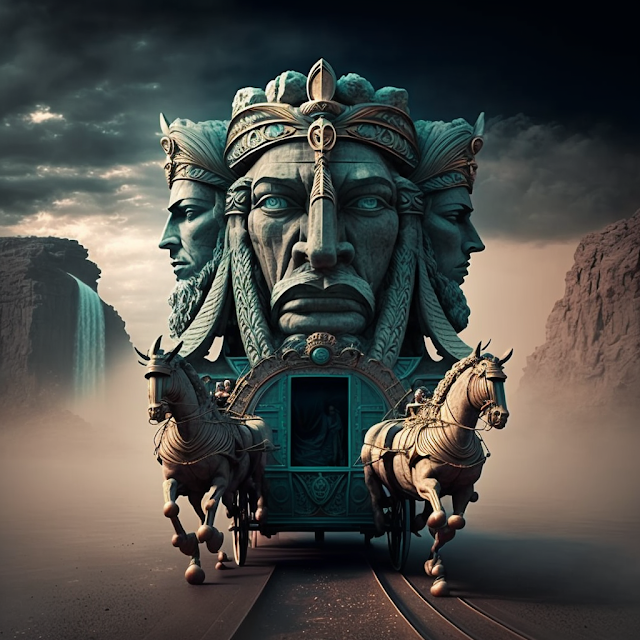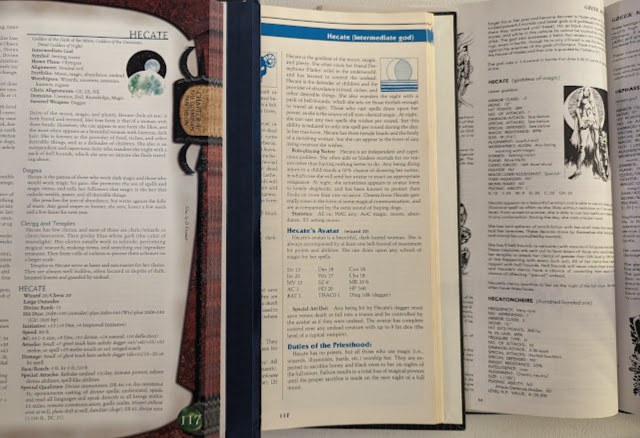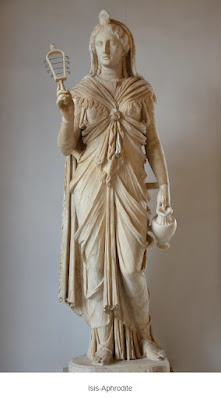In the mythologies of the Ancient World, there are two that really stand out. The Greek and the Egyptian. Both cultures grew to great prominence and fundamentally shaped our world. Both had fascinating tales of gods, monsters, and heroes.
Thanks to the trade and eventual rule of the Ptolemaic Pharos, we have a set of syncretized Greco-Egyptian gods.
While I would happily sit here and talk about these gods in an academic sense, my goal with OMG is really to present these from the lens of D&D, and from the Deities & Demigods in particular. I am going to stick with gods that were actually worshiped, or at least recognized. For this, I am going to rely on the scholarship of others, in particular, that of Dr. Kathrin Kleibl at the German Maritime Museum in Bremerhaven. I am drawing heavily from her chapter (Chapter 41) in The Oxford Handbook of Ancient Greek Religion. She has written more, ok lots more, and her work could form the cornerstone of a new pantheon for a new Deities & Demigods II if such a thing were feasible.
Ptolemaic Egyptian Mythos
In 323 BCE Alexander the Great controlled Egypt, his reign, however, was short-lived and his general Ptolemy took control and his family ruled until 31 CE when they were taken over by Rome. The famous Cleopatra (Cleopatra VII) was the last of their line. The Ptolemaic Pharos or Ptolemaic Kings were not Egyptian but were Greek. They ruled and lived a Greek lifestyle. Only Cleopatra is recorded to have actually learned some of the Egyptian languages. The gods they created or were created around them had a unique blending of both Greek and Egyptian features. Not just physical features, though that is true as well, but religious features and aspects.
Zeus-SerapisBy the time Ptolemy took the throne, there was already syncretism happing in the Egyptian worldview. Serapis was a new popular god figure that combined Osiris with the Apis Bull. In some places, Serapis had already supplanted Osiris as the main God. Zeus-Serapis was an "artificial" conflating of Zeus with Serapis. I say artificial because it was believed he was created by the ministers of Ptolemy I to have a God that could be worshipped by Greeks and Egyptians alike. Newer research has shed some doubt on this interpretation, but for our uses here it does not matter his actual source, only what he became after that.
Zeus was the god of the sky, Osiris was the god of the dead and the god of the Pharos. Zeus-Serapis became the God of the Sun and of Healing. In this, he effectively takes over the "portfolios" of Apollo, Helios, and Ra. As protector of the dead, this also includes the benevolent nature of Hades.
Isis
Isis went from the wife of Osiris and potentially one of the most powerful goddesses in the myths to the Mother of the Gods and thus the pharos. The Ptolemaic Pharos would often take on the epithet of "Sons of Isis." Isis remained a popular goddess well into the Roman age.
Isis was also combined with Aphrodite, a goddess of unknown origin herself. Given the connections between Isis and other goddess like Astarte, Innana, and Ishtar, this sets Isis up as the primary female divinity of the Ancient world.
The "Mysteries of Isis" became a mystery religion that had some outward similarities to the Greek Eleusinian Mysteries associated with Demeter. Her cult with tied to that of Zeus-Serapis, effectively becoming a Father and Mother figure to the Ptolemaic dynasty. In this respect, she takes on the kinder natures of Hera and the dedication of Isis. she would be the one called upon by women in childbirth. Especially when we consider what is going on with Horus.
Horus/Harpokrates
To complete the "holy trinity" of Father-Mother-Child the Greeks renamed Horus, or 'Har-pa-chered' literally "Horus the Child." as Harpokrates. Where he was envisioned as a child-like divinity. Gone was the Avenger Horus and now we get a proto-Christ Child in his place.
Images of Isis nursing the infant Horus would later go on to influence the depictions of the Virgin Mary with infant Jesus.
Anubis/Hermanubis
While not equated with any Greek God in particular Anubis appears as a guide to Isis and advisor of Zeus-Serapis. Some of Osiris' duties as lord of the dead get transferred to Annubis.
In some cases, we have a syncretized Hermes-Anubis, or Hermanubis, as a psychopomp and protector of the dead.
Seth
Going a touch outside of Dr. Kleibl's work we get the god Seth. Also known as Set and Suketh and Setekh. He originally was the good protector god of Upper Egypt. But this was 3,000 years before the Ptolemies. More time between us and the Ptolemies to be honest. Over the centuries Set changed from this benevolent god to the murderer of Osiris and the force of all evil and chaos in the world.
Seth was the name the Greeks called him, and they associated him most with the monster Typhon. Interestingly enough, I find no conflation with Seth and Hades inDr. Kleibl's text. While both were seen as dark, chthonic figures, the Greeks in Egypt did not equate them. But there are still some.
Set/Nephthys and Hades/Persephone
While the associations are not perfect there is a similarity between the relationship of Set and Nephthys with that of Hades and Persephone. Both Nephthys and Persephone are considered goddesses of the underworld and mourning. Both are attached to husbands they would rather leave. Both Hades and Set are complicated gods that are often viewed as evil. Both have been accused of raping or at least coercing their future wives.
I have not found any direct relationship to suggest that they were synchronized, the option certainly feels valid. The conflation of Set with Hades is one of the suspected origins of the Christian Devil; in particular the association of the devil in the desert or "the wilderness" (in Matthew) when he tempts Jesus. Set is the god of the desert and wild places. Though I am not aware of any scholarship that has uncovered a synchronized Set-Hades (see Serapis above).
Nephthys was also commonly conflated with the Greek Nys, Goddess of the Night. As it turns out "Nephthys" is already the Greek name for the Goddess the Egyptians knew as Nebt-het or Nebhet.
Hermes Trismegistus
Not part of Dr. Kleibl's work, but one that really put me on the road to this. Hermes Trismegistus is the synchronized version of Hermes and Thoth. Hermes Trismegistus may have been less of a worshipped figure and more of a translation error when the Greeks were translating the Egyptian writing (hieroglyphic and Demotic). Hermes Trismegistus became more important in later medieval times as the author of the Hermetic Texts.
Heka
This one is also not part of Dr. Kleibl's research but one of my own creations based on her, and other, research. I talked about the Hecate / Heka connections back when I did OMG: Greek Myths and OMG: Egyptian Myths. With the loss of Isis as the Goddess of Magic we have Heka as the new Goddess of Magic and the Underworld. Her relationship with Isis is the same as that of Ishtar with Ereshkigal. This also makes her the perfect goddess of witches.
Hecate was also conflated with the Egyptian Heqet, the Goddess that was the midwife to Isis when Horus was born. Indeed the Greeks also conflated her with Ereshkigal. In this respect she could be considered the sister to the Mother Goddess Isis.
Others
There were plenty more, but it is difficult to know whether these were worship syncretic gods or part of the Interpretatio graeca where the Greeks often substituted names of other gods for their own gods.
For example, the Greek Asclepius is often equated with the Egyptian Imhotep to become the patron of Healing.
The Greek Adonis is equated with the Egyptian Osiris, the Sumerian Dumuzid, and the Phoenician Tammuz to all be equivalent Gods of Agriculture and Grain. This is the same "God figure" of James Frazer's "The Golden Bough." Another god that fits this is the Greek God Dionysus, who is also conflated with Adonis and Osiris.
Looking over this "pantheon" I quickly note there is no god of war. There was Montu for the Egyptians, but the "god of war" was also served by Anhur, Ra, Sekmet, and Set at various times. The Greeks and Romans had Ares and Mars respectively in addition to Athena-Minerva. You see more syncretism with Ares/Mars in later periods, especially with the gods of the Celts and European peoples.
The Greeks did know of Anhur and they called him "Onuris." This is the god of war and battle. His primary goal is to drive out the enemies of Egypt (and Greece). If we were so inclined we could add all the "avenger" aspects lost by Horus when he became Harpokrates. In this, he takes on the role of Protector of Isis, which of course means the protector of Egypt and the line of the Pharohs.
Game Play Uses
It was not AD&D that sent me down the road of this Ptolemaic Egyptian Mythos, but rather Gary Gygax's other game, Dangerous Journeys. Gary's Ægypt fascinated me when I first read about it in the 90s. So much so that when I wanted an Egyptian-like land I used large chunks of this along with Arypt from Mystara and Erypt from the World of Greyhawk. All of this together gave me my Ærypt.
While it would be best to use the Egyptian gods, RAW, from the Deities & Demigods, using these has appeal, even if I have no idea how the "Greeks" got into my world. Maybe something else altogether is in order for that. A future post maybe.
For this "new" Pantheon I would want to relate these Gods in AD&D terms. This is after all the primary focus of One Man's God, not as a treatise on comparative religions. I also don't want or even need, D&DG-style stat blocks. These are not "monsters" to be fought.
I am taking the important bits from the AD&D D&DG, namely"power" levels of the various gods, their alignment, and their worshipper's alignments. While not stated as "Domains" (that's a 3rd Edition term) I am using them here. These are roughly the same as 2nd Ed's "Spheres."
Serapis
Greater God
Alignment: Lawful Good
Worshipper Alignment: Any Good
Domains: Law, Sun, Sky (including storms and rains), the Dead, Rulers
Symbol: Sun
Isis
Greater Goddess
Alignment: Neutral Good
Worshipper Alignment: Any Good, Women (Mysteries of Isis)
Domains: Motherhood, the Home, Childbirth, Love, Fertility
Symbol: Moon or the Roman symbol for Venus
Harpokrates
Greater God
Alignment: Lawful Good
Worshipper Alignment: Any Good
Domains: Life
Symbol: Ankh
Seth
Greater God (or Intermediate God)
Alignment: Chaotic Evil
Worshipper Alignment: Any Evil
Domains: Darkness, Chaos, Desolation
Symbol: Coiled Snake
Nephthys
Greater Goddess (or Intermediate God)
Alignment: Chaotic Neutral
Worshipper Alignment: Any
Domains: Night, Darkness, the Underworld
Symbol: Dark moon
Hermes TrismegistusGreater God (or Intermediate God)
Alignment: Neutral
Worshipper Alignment: Any
Domains: Knowledge, Wisdom, Secrets
Symbol: A circle within a square within a triangle within a circle.
Heka
Lesser Goddess
Alignment: Lawful Neutral
Worshipper Alignment: Any, Witches
Domains: Magic, Witchcraft, Childbirth, Darkness
Symbol: Crescent moon
Adonis (Dionysus-Osiris)
Lesser God
Alignment: Lawful Neutral
Worshipper Alignment: Any
Domains: Agriculture, Grain, Wine, Life-Death-Rebirth
Symbol: Sheath of grain
Onuris
Lesser God
Alignment: Chaotic Neutral
Worshipper Alignment: soldiers, warriors
Domains: War
Symbol: Spear
Asclepius-Imhotep
Demigod
Alignment: Neutral Good
Worshipper Alignment: Any, Healers
Domains: Healing
Symbol: Scalpel
What About the Demons?
This is all fun and everything, but what about the demons of this mythology? We have a "devil" in the form of Seth. I would say that given Egypt's history with demons that some would still be around, but maybe in an altered form. I think given the Greek connection that Demogorgon would be a good choice too. Especially if I move Seth over to Lawful Evil (more devil-like).
With the influences of the Greeks and Romans, Late Period Egypt had an increase in creatures that were more related to the Greek daimon. Demons went from creatures that guarding firey gates to creatures that plagued the Earth with troubles. Egypt at this time was also part of the larger trade routes of first Greece then the Roman Empire, so many gods, goddesses, and demons were filtered through the lens of both ancient and "modern" Egyptian religion.
Guardian Demons
Gate, or Guardian Demons, or  were the most common sort and were usually created by the Gods. Their job was to keep mortals out of their realms. They are demons in the sense that they are supernatural creatures that are neither mortals nor are they gods. These creatures were also described in funerary texts, their names or epithets placed on coffins to protect the dead. They were fierce creatures. Apep and Ammit from the OMG Egyptian Myths could fit this role, but there are others with names like In-tep, Chery-benut, and Ikenty. Ikenty was a large bird-like monster with the head of a cat.
were the most common sort and were usually created by the Gods. Their job was to keep mortals out of their realms. They are demons in the sense that they are supernatural creatures that are neither mortals nor are they gods. These creatures were also described in funerary texts, their names or epithets placed on coffins to protect the dead. They were fierce creatures. Apep and Ammit from the OMG Egyptian Myths could fit this role, but there are others with names like In-tep, Chery-benut, and Ikenty. Ikenty was a large bird-like monster with the head of a cat.
Wanderer Demons
The other class of demons were the Earthly or wanderer demons,  . These are the demons who cause problems on Earth, gave people nightmares, caused disease, and possessed humans.
. These are the demons who cause problems on Earth, gave people nightmares, caused disease, and possessed humans.
I have a Part 4 of this series to do later. I plan on incorporating some of the work of Prof. Panagiotis Kousoulis of the University of the Aegean, Greece. Most of his work is in Greek, so I am digging around for English translations. Part 4 takes this concept of syncretism and demons and dials it up.
But I need to do my Part 3 first.
One Man's God Special: Syncretism

